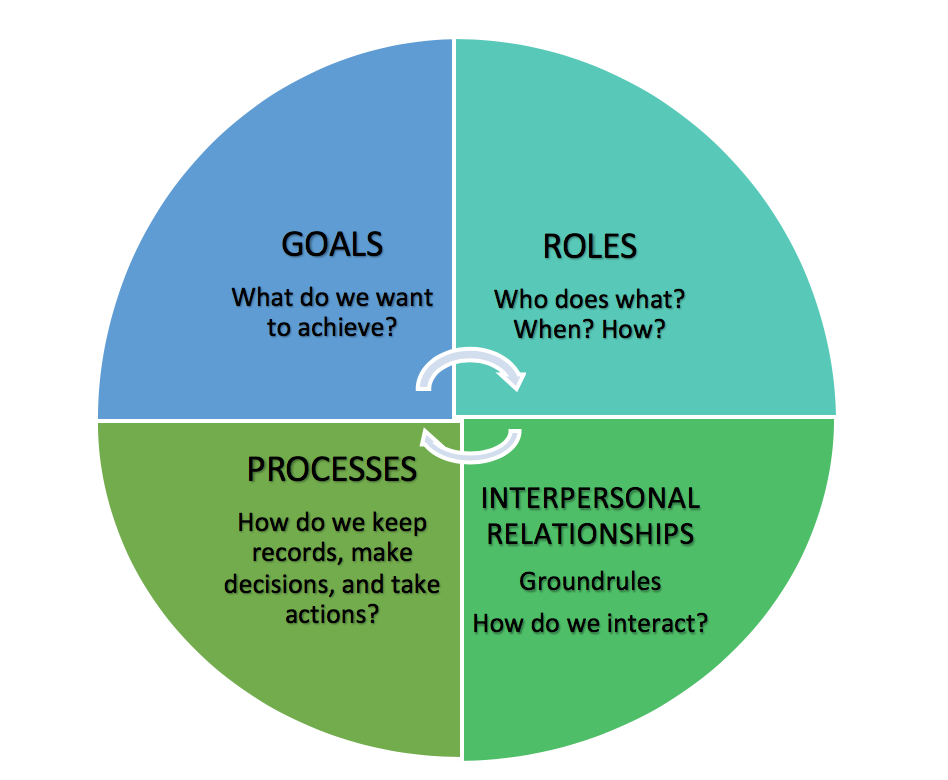Chapter 4 – Project Team
4.7. In-depth Look: GRIP Model of Team Effectiveness
In-depth Look
Team development and effectiveness is a widely popular topic in the professional world with many scholars looking to decipher and develop theories and behaviours to support and improve team outcomes. Along with the 5 Stages of Team Development, there are other useful models to look at when exploring this subject. One such model is the GRPI or GRPI Model of Team Effectiveness, developed by organizational theorist Richard Beckhard, in 1972. This model provides a simple yet comprehensive framework for understanding the key factors that influence team effectiveness (Lucas, n.d.). The broad categories for the GRIP model include the following:
- Goals – Establishing what the team seeks to achieve and ensuring all members understand and are on board.
- Roles and Responsibilities – Clarifying roles and responsibilities, what needs to be done and by whom.
- Interactions/Interpersonal Relationships – The personal relationships within the team, how they interact and relate to one another, as well as trust and feedback (Lucas, n.d.).
- Processes and Procedures – The team’s systems, collaboration strategies, and communication channels.
The model does have its limitations. Some believe it is static and does not take on an in-depth approach to team development in the way the Tuckman’s Group Development does.

The Five Dysfunctions of a Team-Lencioni’s 2005 Model
Not all teams get along with each other. Sometimes, if conflict is not resolved the team can become dysfunctional. The result is a negative team and unproductive results in the project. It is better to understand team development by troubleshooting potential problems. This is where Lencioni’s 2005 model, The Five Dysfunctions of a Team, comes into play. This model explores the common issues teams face and places them on a hierarchical pyramid to guide struggling teams through a resolution:

- Absence of Trust is at the bottom of the pyramid. Lencioni considered this the pillar of team dysfunction, without adequate trust, a team cannot function at even a basic level. It is important for team leaders to be representative of desired team behaviours and “go first” to foster a sense of honesty and integrity.
- Fear of Conflict is next on the pyramid. It is like Tuckerman’s Storming stage. If the team members do not trust each other, they will not be able to resolve the conflict phase. Leaders need to facilitate open communication and set clear objectives.
- Lack of Commitment is next and comes from lack of commitment and unresolved conflict. It can lead to poor decision making, doubt, and negative team cohesion and commitment. Dedicated and effective team members may become frustrated, and leaders need to act on these frustrations to make sure there is closure and clarity of outstanding issues
- Avoidance of Accountability is next. In this phase there is no conformance to an action plan. The team become resistant to dealing with problems within the team or the project. This could include stakeholders of the project too.
- Inattention to Results is at the top of the pyramid. It epitomizes dysfunction and is demonstrated when all other dysfunctions have not been fully resolved. Team members may put their own individual needs above the project needs and objectives. This leads to unsuccessful project results.
Understanding the more difficult elements of team development and how to overcome them is an essential skill for Project Managers and Human Resources Managers.
Class of 2022: Marshall Howman, Daniela Martinez Munoz, Allison Smith, Tania Marisol Toribio Olivares

